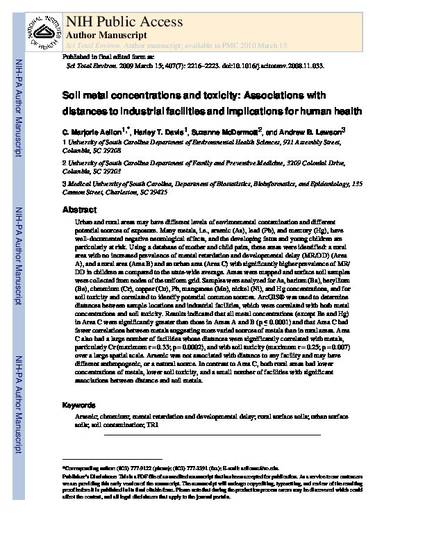
Urban and rural areas may have different levels of environmental contamination and different potential sources of exposure. Many metals, i.e., arsenic (As), lead (Pb), and mercury (Hg), have well-documented negative neurological effects, and the developing fetus and young children are particularly at risk. Using a database of mother and child pairs, three areas were identified: a rural area with no increased prevalence of mental retardation and developmental delay (MR/DD) (Area A), and a rural area (Area B) and an urban area (Area C) with significantly higher prevalence of MR/DD in children as compared to the state-wide average. Areas were mapped and surface soil samples were collected from nodes of the uniform grid. Samples were analyzed for As, barium (Ba), beryllium (Be), chromium (Cr), copper (Cu), Pb, manganese (Mn), nickel (Ni), and Hg concentrations, and for soil toxicity and correlated to identify potential common sources. ArcGIS® was used to determine distances between sample locations and industrial facilities, which were correlated with both metal concentrations and soil toxicity. Results indicated that all metal concentrations (except Be and Hg) in Area C were significantly greater than those in Areas A and B (p ≤ 0.0001) and that Area C had fewer correlations between metals suggesting more varied sources of metals than in rural areas. Area C also had a large number of facilities whose distances were significantly correlated with metals, particularly Cr (maximum r = 0.33; p = 0.0002), and with soil toxicity (maximum r = 0.25; p = 0.007) over a large spatial scale. Arsenic was not associated with distance to any facility and may have different anthropogenic, or a natural source. In contrast to Area C, both rural areas had lower concentrations of metals, lower soil toxicity, and a small number of facilities with significant associations between distance and soil metals.
- arsenic,
- chromium,
- mental retardation and developmental delay,
- rural surface soils,
- urban surface soils,
- soil contamination,
- TRI
Available at: http://works.bepress.com/cmarjorie_aelion/7/
